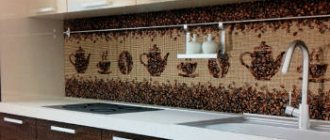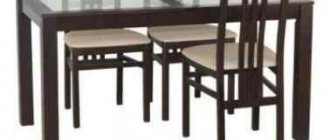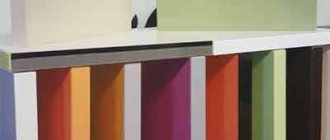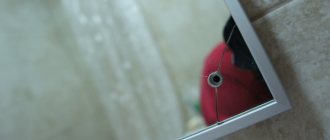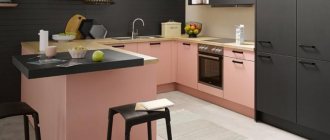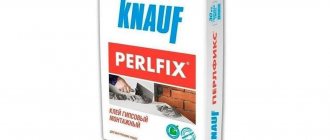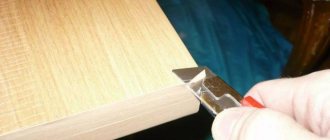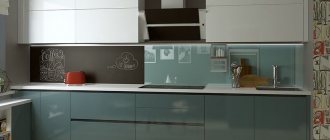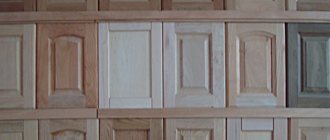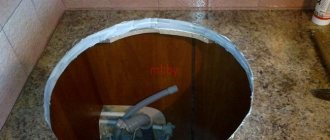Repair
0
53 576
Share
Partial restoration of kitchen facades allows you to update the interior, make it fresher, and visually attractive. Replacing a kitchen unit can be quite expensive, so you can only update the facade. This restoration technology will help change the appearance of the furniture, while its main parts will remain old, which will significantly save on replacing cabinets.
- Benefits of façade renovation
- How to fix the problem?
- Using heating devices
- Restoring coating using friction
- Application of glue
Unlimited possibilities of self-adhesive film
Kitchens covered with film look impressive both in photos and in real life. Surfaces are updated using vinyl or other film. The range of this material is amazing in its diversity, and the price pleases with its affordable price.
Decorative “self-adhesive” imitates:
- natural wood of different species;
- natural stone;
- ceramics and tile texture;
- leather and fabric.
In the photo - imitation wood.
Its texture can resemble patterned silk, a colorful tapestry or cute chintz. The material is produced in matte and glossy versions. There are films with holographic and mirror patterns. And all this can be combined with each other, creating interesting effects, changing an ordinary kitchen cabinet beyond recognition, as in the photo below.
The price of the film depends on the manufacturer and the decorative surface.
Vinyl “self-adhesive” is quite practical because it:
- not afraid of moisture;
- does not fade in the sun;
- does not respond to temperature changes.
With its help, you can completely update the design of both the kitchen and the bathroom, transform the kitchen cabinet or the entire set.
Adhesive film is a good budget replacement for a full-fledged repair. Of course, you need certain knowledge and skills, but the video will help you quickly understand the intricacies of the process.
Replacement of kitchen facades (price for facades)
How much does it cost to replace kitchen facades?
The cost of replacing kitchen facades depends on the following parameters:
- Type of facades. Prices for kitchen facades are all different from 4 tons to 9 or 10 tons per m2. Therefore, the final cost will depend on which facades you choose.2
- Will the fittings and countertops be replaced, or will an additional kitchen cabinet be manufactured?
- Delivery cost Moscow or M.O.
| FACADES MDF FILM | FROM 4,635 RUB. |
| MDF PLASTIC FACADES | FROM 5,900 RUB. |
| FACADES ENAMEL ENAMEL | FROM 7,500 RUB. |
| FACADES MDF VENEER | FROM RUB 7,920 |
| FACADES IN ALUMINUM EDGE | FROM 8,160 RUB. |
| FACADES AL FRAME | INDIVIDUALLY |
| LDSP FACADES | FROM RUB 2,240 |
ONLINE CALCULATION OF FURNITURE FACADES
Which film should I choose?
First of all, you need to look at the thickness of the material and the manufacturer. German “self-adhesive” tapes are of good quality; their price depends on the thickness.
Dutch and Italian manufacturers have proven themselves to be excellent. You can choose something from budget series or take a closer look at exclusive products, but then the price will be quite high.
The most inexpensive are Chinese adhesive decorative materials from unknown manufacturers. However, low price should not be the main selection criterion, otherwise a beautiful kitchen decorated with self-adhesive vinyl film can quickly lose its appearance.
Not all adhesive materials intended for promotional products can be used in the interior. Some of them are designed for short-term use. Choose high-quality decor, and then the restoration will be durable, and a simple kitchen cabinet will become an interior decoration.
The color can be any. If you want to take a creative approach to kitchen design, place photos of fruits, vegetables or flowers on the facades, thereby decorating ordinary old furniture. The drawing can also be applied using photo printing.
Self-adhesive for furniture - what is better to buy
It is important to understand that not all of the film can be glued to slab materials.
If the self-adhesive you randomly chose from the market sticks to the surface of the furniture, then most likely the coating will not be perfectly smooth, but will soon begin to bristle in the corners and will come off after a short period of time. There are two solutions to this problem, namely, to purchase an industrial facade that will not peel off and will look great at the same time. The second solution is to purchase a high-quality film that will have a high level of adhesion to all surfaces, even wood.
Similar materials can be bought in such large construction stores as Leroy Merlin, and the cost will vary from 130 to 900 rubles per roll.
The standard length of a really high-quality coating, having a thickness of 0.3 to 0.5 mm, in a roll will be 2 meters with a width of 0.45 meters. The difference in cost is determined by the thickness of the material you choose and the quality of the adhesive composition. It turns out that the higher the cost of the film, the better it is.
Technology of pasting furniture with polymer films
If you decide to update your kitchen furniture using self-adhesive film, then first prepare the base. It should be understood that the decorative covering will not hide potholes and bumps, it will only disguise the stains, so all unevenness must be removed before pasting. A video with tips will simplify the workflow.
12 rules for working with self-adhesive tape
- The fittings and doors must be removed, and each kitchen cabinet (facades and frame) must be inspected for the presence of depressions and bulges.
- If there are defects on the furniture, all irregularities are filled with putty and sanded well.
- To calculate material consumption, you will need measurements of all parts of the kitchen unit. You need to carefully measure all the parts that you plan to paste over.
- All dimensions are transferred to the back side of the film. It is usually made of white paper, on which the drawn lines are clearly visible.
- When cutting, you should always leave a margin of about 1 cm. This will help in your work: if you start gluing the vinyl at the wrong angle, the margin will make it possible to correct the situation. All excess is easily cut off with a breadboard knife.
- Decorative self-adhesive film is cut with a stationery knife, curved lines are cut out with scissors.
- Then you need to degrease all the surfaces to be decorated so that the “self-adhesive” does not come off over time. Window cleaning liquid or other products are suitable for this. Grease stains need to be treated especially carefully so that the decorative finish does not come off.
- Pasting of kitchen units is carried out on a dry and clean surface, otherwise the “self-adhesive” will begin to bubble and peel off from the base.
- The film must be applied evenly.
- The backing is removed in several stages: first, only a few centimeters are peeled off, after gluing them, a little more is removed, and so on until the entire panel covers the part to be decorated.
- Smooth out the plastic decor from the middle to the edges. Air bubbles must be removed during operation. It is convenient to work with a plastic scraper, stroking the surface with a soft cloth.
- Small air inclusions are removed with a needle. The finished part can be processed through the fabric with a warm iron.
Rules for the operation of facades with PVC film
- If you need to replace the film on the facades, then it is best to look at expensive and high-quality options that can normally withstand high humidity in the kitchen and exposure to high temperatures;
- Various solvents, alkalis and other acids will not have the best effect on the condition of the film;
- You cannot use lighting fixtures that will be installed to the facade with film at a distance of less than 10 centimeters. This is especially true when the lamp uses a conventional incandescent lamp. This will cause the film to begin to fade, wrinkle and burn through;
- Facades with film, which are installed near ovens, must be recessed by 3 or more centimeters relative to a gas or electric stove.
If there are also a few points that are under no circumstances allowed with the use of facades and other furniture that is covered with vinyl film:
- Facades should not be installed next to a source of high heat, or in places where there is direct exposure to sunlight. Otherwise, the film may change its color, which will lead not only to the loss of the attractive appearance of the entire product, but also to peeling of the film;
- It has been laboratory proven that it is prohibited to use facades and other furniture with glued vinyl film at temperatures below 20 degrees and above 60 degrees, relative to an air humidity of 80%. Otherwise, significant damage to the material occurs;
- After replacing the film on the facade, you need to wait several hours so that it is well fixed on the surface. After this, the facade can be returned to its place. Otherwise, cracking of the film may occur;
- It is necessary to exclude, as far as possible, moisture from entering the façade. If this happens, try to immediately remove the moisture using a soft cloth.
Difficulties in work and their solutions
Problems often arise with processing the ends and shaped parts of kitchen units made of MDF or other material. An industrial or household hair dryer will be a good helper in this case.
The restoration will go faster if you work together: one person stretches the material by heating it with a hairdryer, the other carefully glues it to the base.
It is easier to apply the self-adhesive tape evenly on a damp surface. To do this, lightly moisten cabinets and doors with a spray bottle. Water will not allow the material to immediately grasp the surface and will provide an opportunity to correct the work.
When cutting the material, you need to make allowances on each side. For parts with ends, do not forget to make cuts in the corners. First, they paste over the part itself, and then proceed to the ends. The rounded ends of MDF facades are treated with a hairdryer for a better fit.
A simple screen made of plastic pipes for a kindergarten: do it yourself
There are several ways to solve the problem. For starters, this is a complete replacement of facades that are no longer suitable for restoration. If you just want to put the film back in place, there are several solutions you can use. For starters, this is the temperature effect. By heating the glue, it returns its characteristics, begins to cling to the surface, and thereby the facade is restored. An alternative is to use glue. Moreover, the experts advise first to try the first method, and then switch to glue.
Let me separately and as briefly as possible try to talk about restoration methods.
Friction recovery
This may seem strange to some, but the method really works.
It is best to use this technique in the early stages, when the film has only recently peeled off.
The meaning of the procedure is to perform the following sequential actions:
- it is advisable to remove the problematic door or facade;
- prepare a clean, dry cloth;
- place the facade on a flat horizontal surface;
- apply a rag to the problem area;
- start moving the rag with slight pressure back and forth;
- try to wipe away the peeled off area;
- the temperature due to friction will gradually increase;
- the dried glue will warm up;
- its adhesion properties will return;
- the film will return to its place.
Just don't rub too quickly or vigorously. Take short breaks, don't put too much effort. Otherwise, the film may be damaged.
Heating with a hair dryer
An alternative would be another method of heating the film, but using an appropriate device.
A regular hair dryer may work, but it is better to use a construction hair dryer.
In this case, the sequence of operations is as follows:
- remove the façade;
- lay on the surface so that it is convenient to work;
- turn on the hairdryer;
- select medium heating mode;
- start warming up the film and facade;
- when the glue warms up, take a clean rag in your hand;
- start rubbing the film into the facade, working from the center to the edges.
The method will help if the glue has really dried out and lost its properties. Having melted it, it is often possible to restore it without using a new layer of glue.
Restoration with glue
Often home craftsmen first start with this method. But here everyone decides for himself.
To work, you will need quick-drying glue. Choose any one at your discretion.
The composition must be applied to the inner surface of the film and to the MDF facade itself. Then press and gently rub.
Restoration of facades with decorative film
The appearance of the kitchen largely depends on the cladding of the facades. If your kitchen has smooth doors without a relief made of chipboard, then they can be easily covered with vinyl film.
Updating kitchen MDF facades with convexes will be easier if you use an industrial hair dryer. Only a well-heated film can take the desired shape. If there are decorative details on the facades, they must be removed before pasting.
Replacement of the old film is carried out only after removing the previous layer. Remember that decorative film is only applied to prepared surfaces.
It should be taken into account that in production, MDF film facades pass through a special press, which makes it possible to obtain a smooth surface without flaws. At home, MDF can only be covered with self-adhesive.
Benefits of façade renovation
Self-adhesive film was used to restore the facades. There are times when it begins to come off: if the MDF film has peeled off in the kitchen, you should not rush to replace it with a new one. The film often peels off due to humidity, temperature changes, steam, and the use of low-quality glue.
You should not be surprised if peeling occurs quite quickly, even during loading after manufacture or when the product has a short lifespan. The film peels off from MDF facades for the following reasons:
- The glue is not applied to the entire surface. When the substance is applied manually, the worker often misses sections of the product and the film does not stick to them. You can solve the problem by using colored glue.
- Using a cheap, poor quality substance. Quite often a two-component polyurethane composition is used. It is quite difficult to mix it in the correct proportion, so the glue hardens incorrectly and does not hold well, and bubbles may appear on the film.
- Using expired glue. When using such a material, the film will stick, but will peel off fairly quickly.
- Insufficient temperature during gluing, as a result of which the connection did not go well enough. There can be many reasons: poorly heated film, the vacuum was applied too early, the adhesive layer was thin, the workpieces for the facades were cold, it could have been cold in the workroom, the film was not pressed well enough, due to a weak vacuum supply, the wrong adhesive was chosen, the composition of which does not come into contact with a specific film. The facades themselves could also be used incorrectly: for example, they were located next to heating appliances, a stove, or sources of moisture. Before purchasing, it is important to find out how to properly care for furniture and for what conditions it was made.
Interior renovation using film
Designers love polymer films. They have good plasticity and decorative properties; with their help you can quickly update almost any surface. Material suitable for decoration:
- tiles in the bathroom or kitchen;
- wall panels;
- doors;
- different furniture.
Films are available in different colors, with and without patterns. With their help, you can update your kitchen set and change old furniture in your home without extra costs. After all, the price of even the most expensive film will be cheaper than a new headset.
Restoring tiles using vinyl is not difficult. It is important to choose the right drawing here. Delicate chintz designs or films with textured embossing are suitable for the kitchen.
Complete the design with a decorative kitchen apron. Its restoration using film usually does not cause difficulties. The main thing is to carefully read the instructions on the roll.
Before gluing the tiles in the bathroom, you need to carefully prepare the surface - degrease it well. Otherwise, the film will quickly peel off.

